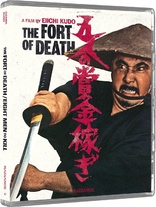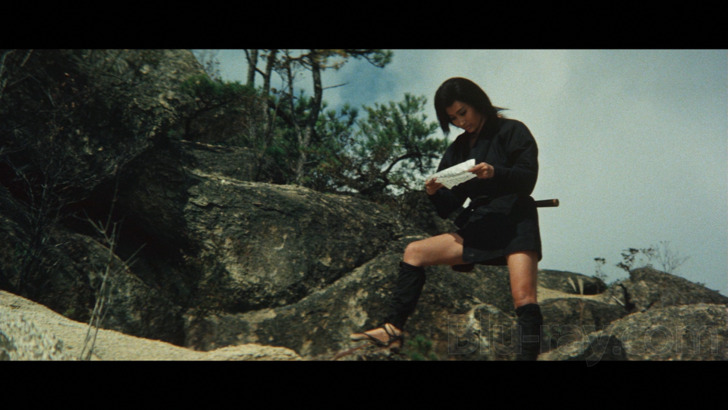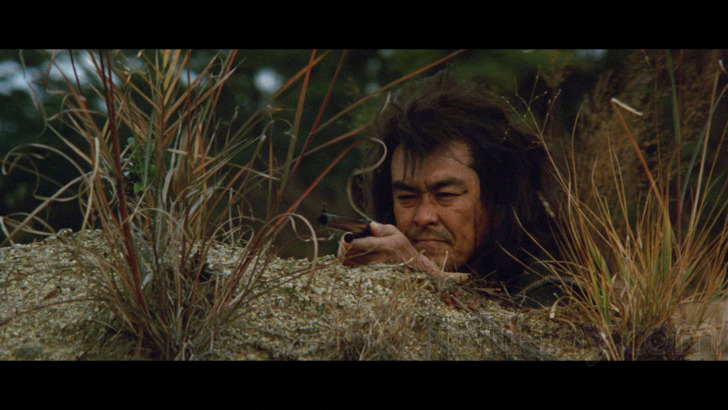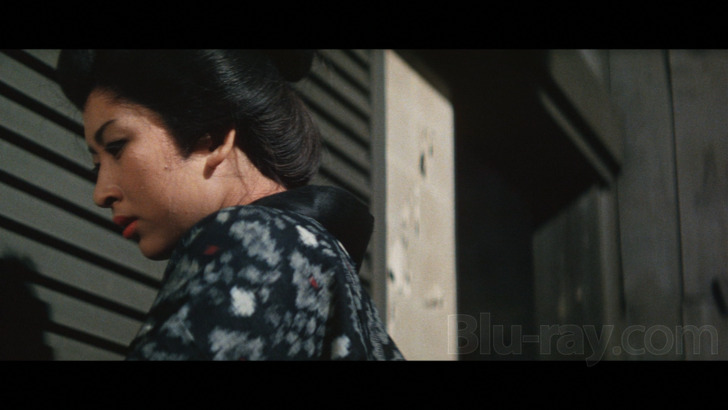The Fort of Death Blu-ray Movie
HomeThe Fort of Death Blu-ray Movie 
五人の賞金稼ぎ / Gonin no shōkin kasegiRadiance Films | 1969 | 97 min | Not rated | No Release Date

Price
Movie rating
7.2 | / 10 |
Blu-ray rating
| Users | 0.0 | |
| Reviewer | 4.0 | |
| Overall | 4.0 |
Overview
The Fort of Death (1969)
After a plan to force the farmers of Enoki Village to partake in the rebuilding of Edo Castle crumbles, the government lays siege to the peasant hamlet. Upon taking away their food, heavily taxing them, and murdering those who refuse to pay, the villagers lead an uprising by building a fort around their homestead from which to defend themselves. Fearing the government will eventually wipe them out, a young man seeks the help of the famous bounty hunter, Shikoro Ichibei and his small band of specialists.
Starring: Bin Amatsu, Kanjûrô Arashi, Seizô Fukumoto, Gorô Ibuki, Eizô KitamuraDirector: Eiichi Kudo
| Foreign | Uncertain |
| Action | Uncertain |
Specifications
Video
Video codec: MPEG-4 AVC
Video resolution: 1080p
Aspect ratio: 2.34:1
Original aspect ratio: 2.35:1
Audio
Japanese: DTS-HD Master Audio 2.0 Mono
Subtitles
English
Discs
Blu-ray Disc
Single disc (1 BD)
Playback
Region A (B, C untested)
Review
Rating summary
| Movie | 4.0 | |
| Video | 3.5 | |
| Audio | 4.0 | |
| Extras | 2.0 | |
| Overall | 4.0 |
The Fort of Death Blu-ray Movie Review
Reviewed by Jeffrey Kauffman March 25, 2024 Note: This film is available on Blu-ray as part of Radiance Films' release of The Bounty Hunter Trilogy.
There's a trend in many contemporary restaurants where "fusions" of different cultures' menus are combined to offer something new and ostensibly
improved. For anyone who may be under the impression that this same general "mixing" approach is something recent, The Bounty Hunter
Trilogy
should provide a cinematic
example that "fusions" have been around for quite some time. As commentator Tom Mes kind of jokingly refers to in his track on the first film in
this
set, anyone looking for historical accuracy in these films had best keep searching elsewhere, especially since production design elements can often
weirdly interpolate "wrong" decades (or even centuries) into the proceedings. But even that "combo platter" may not be as viscerally
noticeable
as the often quite interesting ping ponging in all three films between "traditional" Japanese (quasi?) samurai outings, what might be generally
termed
Spaghetti Western elements, and, perhaps most intriguingly (and another way these films tend to bend perceived eras or at least genres to their
own uses), a kind of James Bond-
esque spy film aspect. It wouldn't be until 1972, the year of this trilogy's final entry, that star Tomisaburô Wakayama would start appearing as one
of two legendary titular characters in what is
arguably his better remembered series,
Lone Wolf and Cub. While that might kind of unavoidably seem to make The Bounty Hunter Trilogy a "test run" of sorts, it
probably
really isn't, as this earlier triptych has its own distinct flavor (speaking of fusion menus).

If Killer's Mission might arguably be seen as emphasizing its "retro James Bond" aspects, The Fort of Death probably tends to focus more overtly on Spaghetti Western elements, in this sophomore effort which perhaps saliently was not directed by Shigero Ozawa, who helmed both the first and third entries in the series. Instead Eiichi Kudo is on hand in what was evidently a very quickly produced follow up when Killer's Mission proved to be so successful. If the entire Bounty Hunter Trilogy kind of unapologetically alludes to any number of other films and/or franchises (as outlined in part above), The Fort of Death may subliminally offer a "hold my sake" to the audience as it unabashedly makes use of tropes featured prominently in Seven Samurai , as even the cover verbiage of this release overtly mentions.
Ichibei (Tomisaburô Wakayama) is once again on hand as the perhaps last refuge of a bunch of farmers beset by a nefarious warlord. The farmers with Ichibei basically turn their village into an armed fortress, waiting for the inevitable onslaught by government fighters. There's an unexpected emotional heft to this sophomore effort that Killer's Mission probably didn't even attempt to deliver. The pace is almost breakneck at times here, but there's still some effective character development, and the action set pieces are imaginatively choreographed and shot.
The Fort of Death Blu-ray Movie, Video Quality 

The Fort of Death is presented on Blu-ray courtesy of Radiance Films with an AVC encoded 1080p transfer in 2.34:1. Radiance tends not to provide a ton of technical information on their releases, and that's once again the case with all three films in this set, which are lumped together in Radiance's insert booklet with the following very brief notes on the transfers:
Each film in The Bounty Hunter Trilogy was transferred in high definition by Toei Company Ltd and supplied to Radiance Films as high definition digital masters.While all three films in Radiance's The Bounty Hunter Trilogy offer generally secure merits, I'd probably rate The Fort of Death as just slightly less consistent looking than the first film in the series. These are admittedly quite small differences, but The Fort of Death can at times offer a somewhat faded look that can be especially noticeable in some of the outdoor material. At times things can skew slightly toward browns, at others there's a subtle but noticeable green-yellow look, something that may be most noticeable in terms of how blue skies can be in outdoor scenes. It's a passing qualm and one that doesn't seriously undermine an otherwise quite positive viewing experience. Detail levels are very good in controlled, set bound material, but understandably a bit more variant in the many outdoor scenes. Fine detail on things like costume fabrics tends to be excellent, though again most noticeable in more controlled environments. Grain is once again quite heavy at times, but resolves without any issues. My score is 3.75.
The Fort of Death Blu-ray Movie, Audio Quality 

The Fort of Death features an often pretty bombastic sounding DTS-HD Master Audio 2.0 Mono track in the original Japanese. While this track shares the same kind of general boxiness that attends all three films' audio presentations, there's a rather decent midrange throughout and some bursts on the low end in some of the action scenes can have commendable energy as well. There is some very minor background noise in the few relatively quiet moments. Dialogue is rendered cleanly and clearly throughout. Optional English subtitles are available.
The Fort of Death Blu-ray Movie, Special Features and Extras 

Radiance has packaged The Fort of Death and Eight Men to Kill together on one disc, with the following supplements:
- Robin Gatto (HD; 18:00) is an interesting visual essay by "Samurai film connoisseur" Robin Gatto, focusing mainly on The Fort of Death and director Eiichi Kudo.
- Gallery (HD)
- The Fort of Death Trailer (HD; 3:20)
- Eight Men to Kill Trailer (HD; 3:07)
The Fort of Death Blu-ray Movie, Overall Score and Recommendation 

While there's simply no denying how "reminiscent" The Fort of Death is of other films, I actually think I liked this second effort a bit more than Killer's Mission, perhaps contradicting that oft mentioned symptom of the so-called "sophomore slump". Video is arguably just a bit less consistent looking here than in the first film, but is still generally great looking, and the visual essay in particular is very interesting. Recommended.
Similar titles
Similar titles you might also like
(Still not reliable for this title)

Eight Men to Kill
賞金首 一瞬八人斬り / Shōkin kubi: Isshun hachi-nin giri
1972

Killer's Mission
賞金稼ぎ / Shōkin kasegi
1969

Resurrection
新・忍びの者 / Shin shinobi no mono
1963

Revenge
続・忍びの者’ / Zoku shinobi no mono / Shinobi No Mono 2: Vengeance
1963

Band of Assassins
忍びの者 / Shinobi no mono / Ninja, A Band of Assassins
1962

Black Tight Killers
Ore ni sawaru to abunaize | Standard Edition
1966

By a Man's Face Shall You Know Him
男の顔は履歴書
1966

Tokijiro: Lone Yakuza
沓掛時次郎 遊侠一匹 / Kutsukake Tokijirō - yūkyō ippiki | Limited Edition
1966

Fearless Hyena II
龍騰虎躍 / Lóng téng hǔ yuè
1983

Hokuriku Proxy War
北陸代理戦争 / Hokuriku dairi sensô | Limited Edition
1977

Tiger Cage III
Lang mien jeu keun sau / Leng mian ju ji shou / 冷面狙擊手
1991

Death Valley
Duan hun gu
1968

Beach of the War Gods
Zhan shen tan / 戰神灘
1973

Detonation: Violent Riders
爆発!暴走族 / Bakuhatsu! Boso zoku
1975

Iron Angels II
Tian shi xing dong II huo feng kuang long / 天使行動II火鳳狂龍
1988

The Deadly Knives
1972

The Singing Thief
大盜歌王 / Da dao ge wang
1969

The Most Dangerous Game
Mottomo kiken na yuugi / 最も危険な遊戯 / Games of Maximum Risk
1978

Black Cat 2
黑貓II:刺殺葉利欽
1992

The Double Crossers
鬼計雙雄 / Guǐ jì shuāng xióng / Eureka Classics
1976